人教版八年级上册 Unit 3 I'm more outgoing than my sister.Section A (1a-1c) 课件 (共28张PPT,无音频)
文档属性
| 名称 | 人教版八年级上册 Unit 3 I'm more outgoing than my sister.Section A (1a-1c) 课件 (共28张PPT,无音频) | 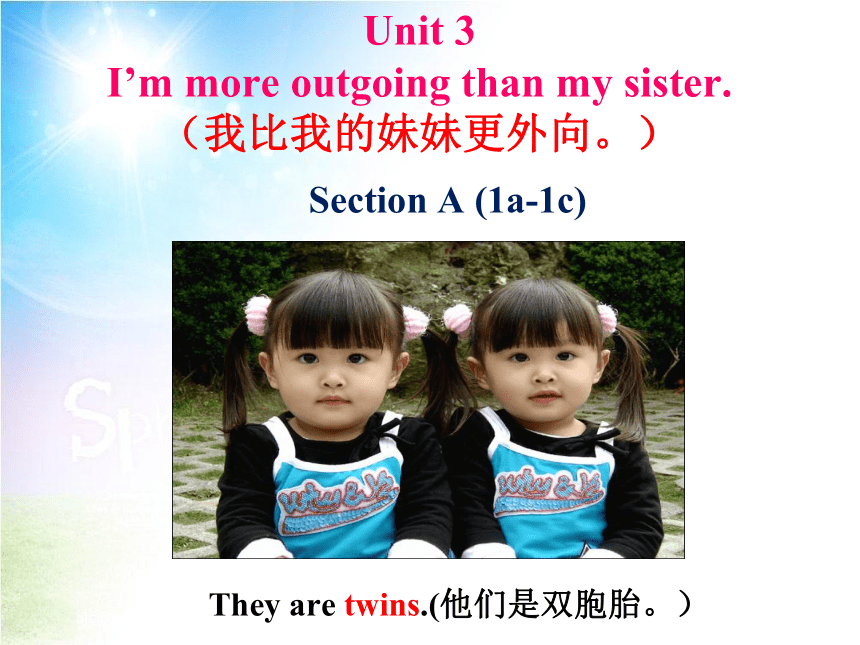 | |
| 格式 | zip | ||
| 文件大小 | 4.0MB | ||
| 资源类型 | 教案 | ||
| 版本资源 | 人教新目标(Go for it)版 | ||
| 科目 | 英语 | ||
| 更新时间 | 2022-08-20 15:01:26 | ||
图片预览

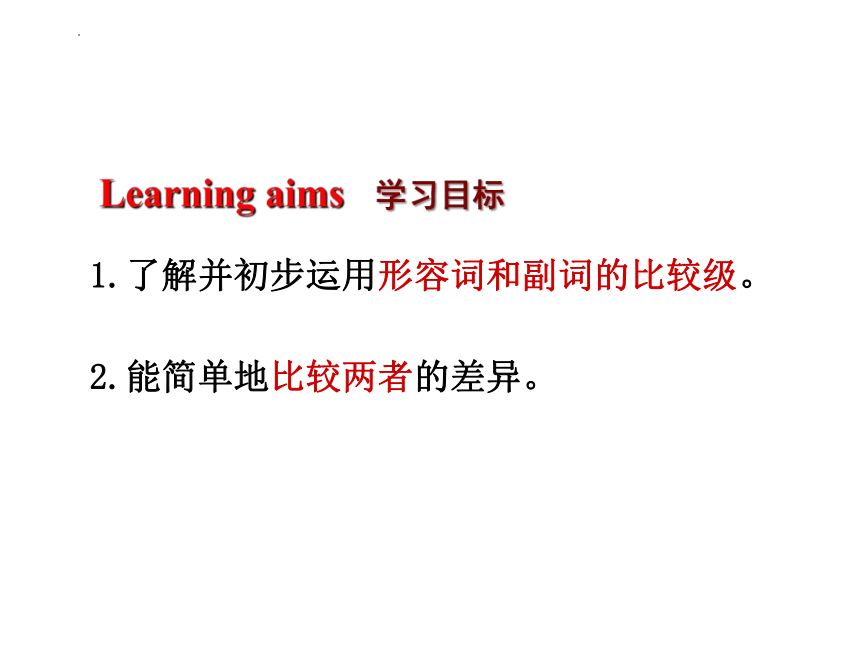
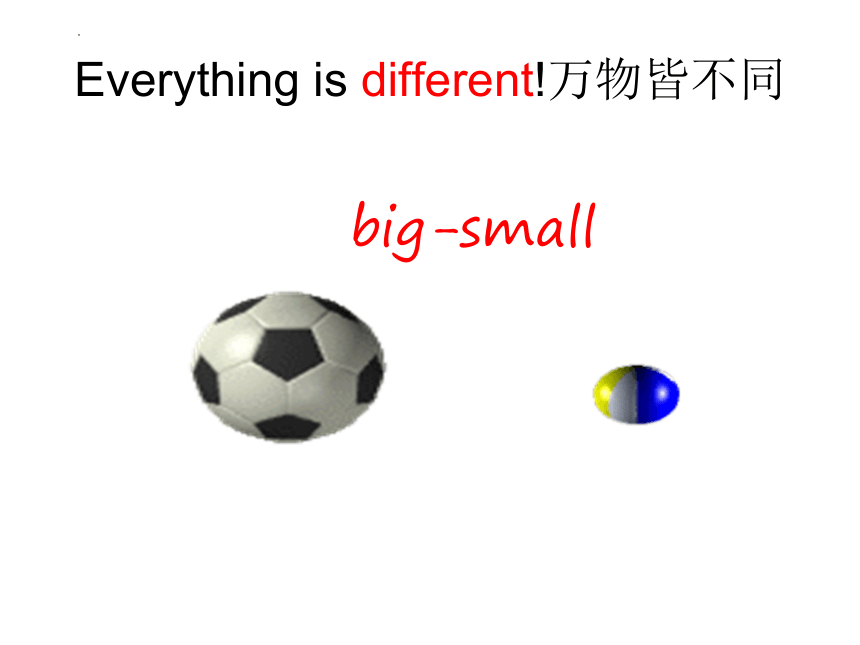
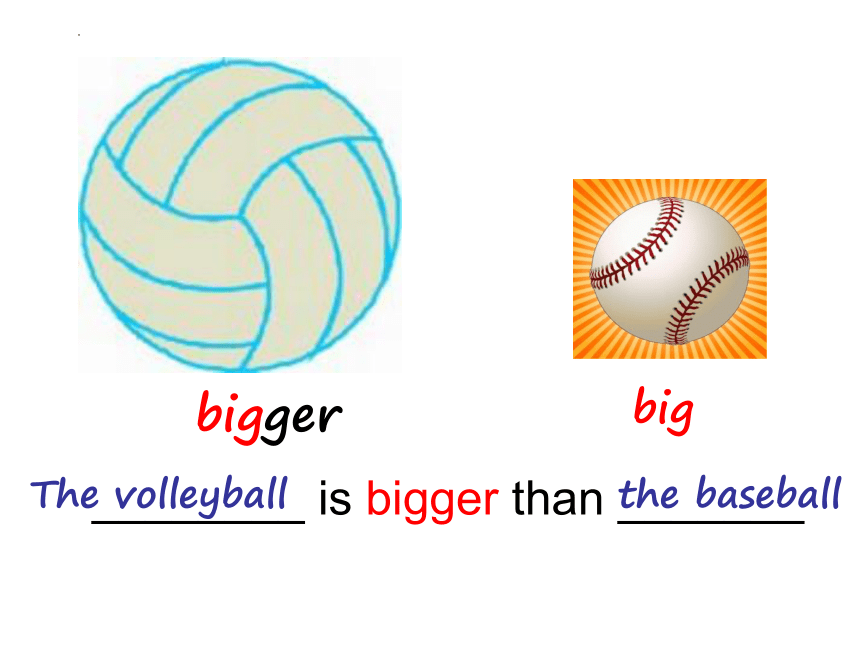

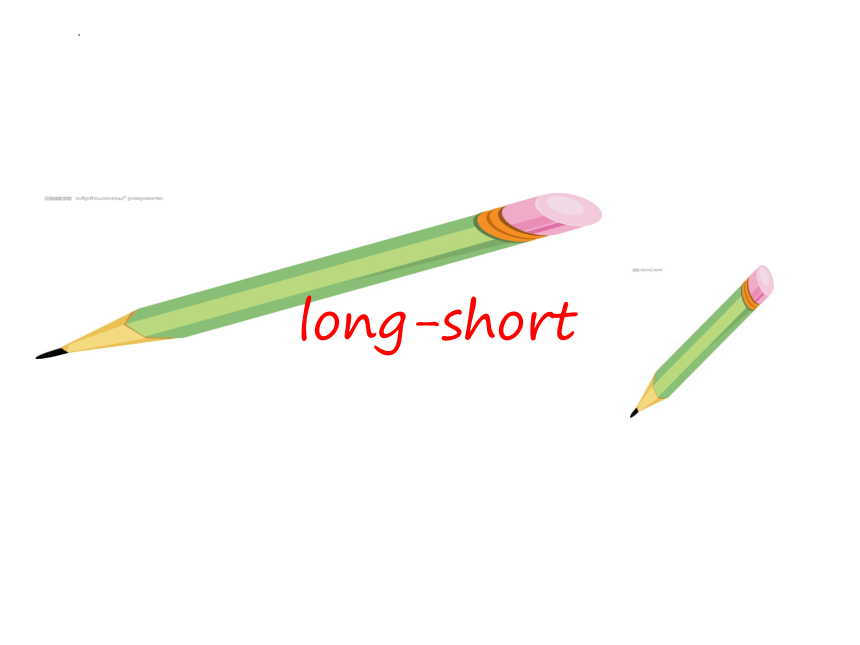
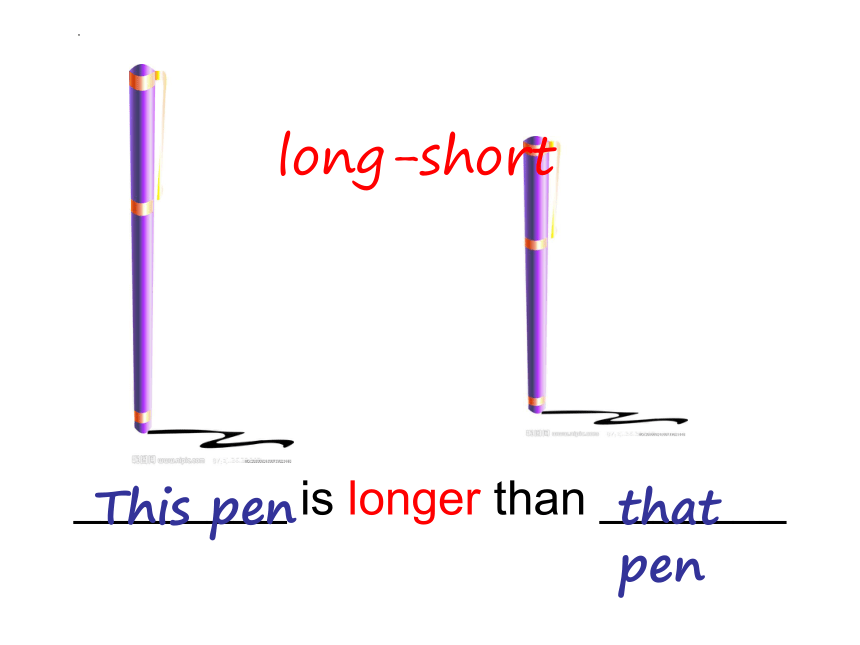
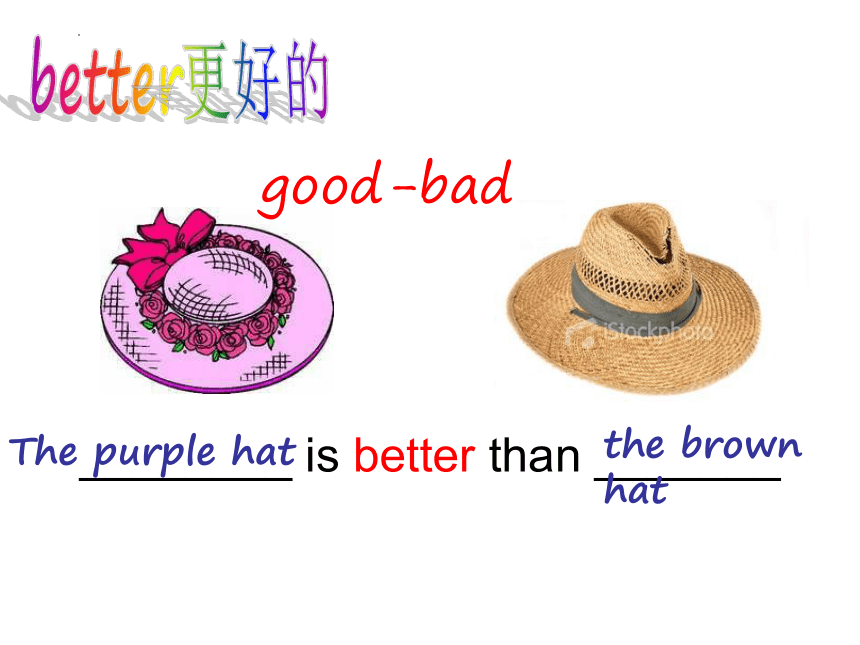
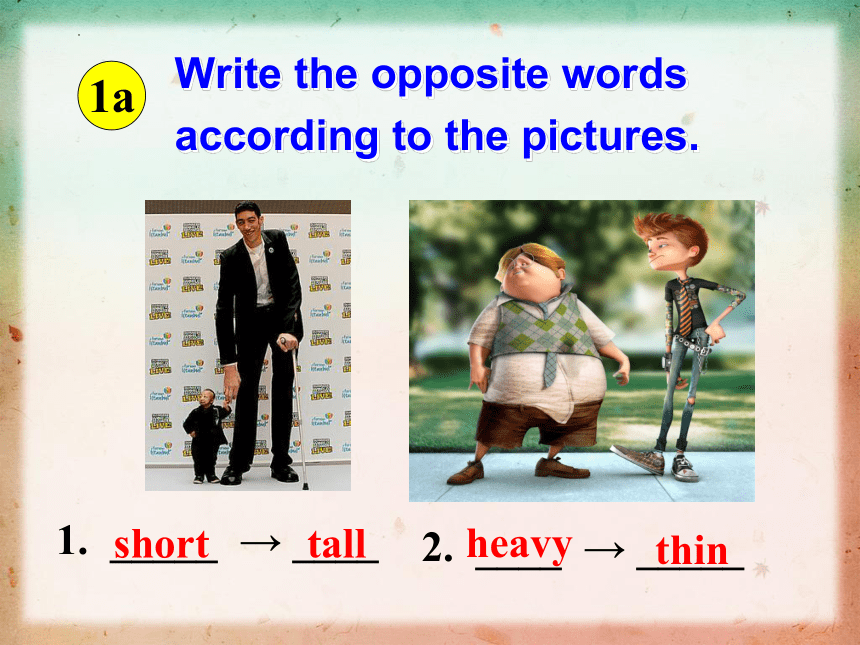
文档简介
(共28张PPT)
Unit 3
I’m more outgoing than my sister.
(我比我的妹妹更外向。)
Section A (1a-1c)
They are twins.(他们是双胞胎。)
1.了解并初步运用形容词和副词的比较级。
2.能简单地比较两者的差异。
Learning aims 学习目标
Everything is different!万物皆不同
big-small
big
bigger
________ is bigger than _______
The volleyball
the baseball
small
smaller
___________is smaller than _________
The ping pong ball
the tennis ball
long-short
________ is longer than _______
This pen
that pen
long-short
good-bad
________ is better than _______
The purple hat
the brown hat
better更好的
2. ____ → _____
1. _____ → ____
short
heavy
thin
tall
Write the opposite words according to the pictures.
1a
3. ______ → ______
quietly
loudly
4. _________ → _________
short hair
long hair
tall loudly
thin short hair
long hair heavy
quietly short
Match each word with its opposite.
1a
er
more
ner
er
er
heavier
more
er
反义词
注意:1.be+adj. 2.实意v.+adv.
There are three pairs of twin brothers and sisters in the picture. Who’s whose twin brother or sisters Why
1b
Because both Tara and Tina have “T” and “a”. Because Tom and Sam both have three letters in their names and they both have an “m”.
…
Let’s have a look at these twins.
Talk about the differences.
Who is heavy, Peter or Paul
Who has long hair, Tom or Sam
Who is quiet, Tom or Sam
Who sings loudly, Tina or Tara
Who is short and thin, Peter or Paul
Peter
Sam
Tom
Tina
Paul
Listen and number the pairs of twins in the picture.
1b
1
2
3
1.both ... and ... 意为“……和……都”(两者),连接两个并列成分。当连接两个并列主语时,谓语动词用复数形式。
e.g. Both she and I are middle school
students.
2.both of them/us 意为“他/我们两个都…”
3.all …都(三者/三者以上)
Pair work
1c
Practice the conversation then make conversations about the other twins.
A: That’s Tara, isn’t it
B: No, it isn’t. It’s Tina. Tina is taller than Tara. And she also sings more loudly than Tara.
Hi,…
I am taller than you.
And I am more outgoing than you.
Hmm, I have longer hair than you.
Compare you and your partner with the words in 1a.
And I speak more loudly than you.
Yeah, but I am thinner than you.
Yes, you are right.
_______
19
探究点1:形容词和副词的基本用法
观察下列句子,注意句子中形容词和副词的用法。
1. She is an outgoing girl.
2. But the most important thing is to learn
something new and have fun.
3. Peter is tall.
4. I run fast and jump high.
5. Most fast food is unhealthy.
6. Sam is a very hard-working boy.
7. Nelly sang so well.
20
⑴形容词既可以放在名词之_____或不定代词之
_____做定语,也可以放在系动词之_____做表语,还可以放在宾语之______做宾语补足语。
⑵副词常用作状语,既可以修饰________、
_________或其他副词。
⑶某些形容词可以在后加上-ly变成副词, 如:slow-slowly, quick-quickly, quiet-quietly,loud-loudly,clear-clearly等;注意: 一些 单词既是形容词, 也是副词,如: fast,high,early, late, hard等,在具体使用时要仔细辨认。
前
后
后
后
动词
形容词
21
探究点2:形容词和副词的比较级(一)
Tara works as hard as(与……一样地努力)Tina.
2. Tina is taller (更高) than Tara.
3. Peter is heavier (更胖) than Paul.
4. I get up later (更晚) than my parents.
5. My schoolbag is bigger (更大)than yours.
6. I’m more outgoing(更外向)than my sister.
7. Nelly danced better(更好)than Lisa.
朗读下列句子,注意画线部分及其含义意思。
22
英语中, 两者(人或物)相比较时, 要用形容词
和副词的比较级:
⑴形容词和副词比较级的构成:
①一般情况下,直接在单词末尾加_____;
②以字母e 结尾的单词,直接在词尾加_____;
③以 “辅音字母+ y ”结尾的单词,先变____为
____,再加 _____;
④以重读闭音节结尾的单词且词尾只有一个辅
音字母时, 应先双写这个辅音字母, 再加-er;
⑤多音节和部分双音节词,直接在单词前加
__________;
-er
-r
y
i
-er
more
23
⑥有些单词的变化不规则,需要特殊记忆,如:
good /well — better(更好),
bad/ badly/ill — worse(更坏),
many/much — more(更多) ,
little — less(更少)
far — farther/further(更远),
old — older/elder(更大/更老)
24
(2)比较级的用法:
①如果两个程度相同的事物或人进行比较时,用“_____+ _______________+ ____ ”的结构,
意为“和…一样”,其否定形式为” not as/so
+ 形容词/ 副词原级+ as”, 意为“…不如…”;
②如果两个比较对象程度不相同时,用 “ _______
+ _______ ”的结构,表示“一个比另一个更…”或“较…”。连词than后接代词时,一般用主格,在口语中可以用宾格。当than前后使用的动词相同时,后面的动词通常用助动词代替,改动词或助动词可以省略。
形容词/副词原级
as
as
比较级
than
Exercises
写出下列单词的比较级。
funny
quiet
serious
smart
outgoing
quickly
funnier
quieter
more serious
smarter
more outgoing
more quickly
tall
nice
big
funny
outgoing
old
older
taller
nicer
bigger
funnier
more outgoing
late
expensive
thin
smart
high
fat
interesting
more interesting
later
more expensive
thinner
smarter
higher
fatter
1、背诵U.2的2d和Grammar Focus.
2、预习课文P.18。
Unit 3
I’m more outgoing than my sister.
(我比我的妹妹更外向。)
Section A (1a-1c)
They are twins.(他们是双胞胎。)
1.了解并初步运用形容词和副词的比较级。
2.能简单地比较两者的差异。
Learning aims 学习目标
Everything is different!万物皆不同
big-small
big
bigger
________ is bigger than _______
The volleyball
the baseball
small
smaller
___________is smaller than _________
The ping pong ball
the tennis ball
long-short
________ is longer than _______
This pen
that pen
long-short
good-bad
________ is better than _______
The purple hat
the brown hat
better更好的
2. ____ → _____
1. _____ → ____
short
heavy
thin
tall
Write the opposite words according to the pictures.
1a
3. ______ → ______
quietly
loudly
4. _________ → _________
short hair
long hair
tall loudly
thin short hair
long hair heavy
quietly short
Match each word with its opposite.
1a
er
more
ner
er
er
heavier
more
er
反义词
注意:1.be+adj. 2.实意v.+adv.
There are three pairs of twin brothers and sisters in the picture. Who’s whose twin brother or sisters Why
1b
Because both Tara and Tina have “T” and “a”. Because Tom and Sam both have three letters in their names and they both have an “m”.
…
Let’s have a look at these twins.
Talk about the differences.
Who is heavy, Peter or Paul
Who has long hair, Tom or Sam
Who is quiet, Tom or Sam
Who sings loudly, Tina or Tara
Who is short and thin, Peter or Paul
Peter
Sam
Tom
Tina
Paul
Listen and number the pairs of twins in the picture.
1b
1
2
3
1.both ... and ... 意为“……和……都”(两者),连接两个并列成分。当连接两个并列主语时,谓语动词用复数形式。
e.g. Both she and I are middle school
students.
2.both of them/us 意为“他/我们两个都…”
3.all …都(三者/三者以上)
Pair work
1c
Practice the conversation then make conversations about the other twins.
A: That’s Tara, isn’t it
B: No, it isn’t. It’s Tina. Tina is taller than Tara. And she also sings more loudly than Tara.
Hi,…
I am taller than you.
And I am more outgoing than you.
Hmm, I have longer hair than you.
Compare you and your partner with the words in 1a.
And I speak more loudly than you.
Yeah, but I am thinner than you.
Yes, you are right.
_______
19
探究点1:形容词和副词的基本用法
观察下列句子,注意句子中形容词和副词的用法。
1. She is an outgoing girl.
2. But the most important thing is to learn
something new and have fun.
3. Peter is tall.
4. I run fast and jump high.
5. Most fast food is unhealthy.
6. Sam is a very hard-working boy.
7. Nelly sang so well.
20
⑴形容词既可以放在名词之_____或不定代词之
_____做定语,也可以放在系动词之_____做表语,还可以放在宾语之______做宾语补足语。
⑵副词常用作状语,既可以修饰________、
_________或其他副词。
⑶某些形容词可以在后加上-ly变成副词, 如:slow-slowly, quick-quickly, quiet-quietly,loud-loudly,clear-clearly等;注意: 一些 单词既是形容词, 也是副词,如: fast,high,early, late, hard等,在具体使用时要仔细辨认。
前
后
后
后
动词
形容词
21
探究点2:形容词和副词的比较级(一)
Tara works as hard as(与……一样地努力)Tina.
2. Tina is taller (更高) than Tara.
3. Peter is heavier (更胖) than Paul.
4. I get up later (更晚) than my parents.
5. My schoolbag is bigger (更大)than yours.
6. I’m more outgoing(更外向)than my sister.
7. Nelly danced better(更好)than Lisa.
朗读下列句子,注意画线部分及其含义意思。
22
英语中, 两者(人或物)相比较时, 要用形容词
和副词的比较级:
⑴形容词和副词比较级的构成:
①一般情况下,直接在单词末尾加_____;
②以字母e 结尾的单词,直接在词尾加_____;
③以 “辅音字母+ y ”结尾的单词,先变____为
____,再加 _____;
④以重读闭音节结尾的单词且词尾只有一个辅
音字母时, 应先双写这个辅音字母, 再加-er;
⑤多音节和部分双音节词,直接在单词前加
__________;
-er
-r
y
i
-er
more
23
⑥有些单词的变化不规则,需要特殊记忆,如:
good /well — better(更好),
bad/ badly/ill — worse(更坏),
many/much — more(更多) ,
little — less(更少)
far — farther/further(更远),
old — older/elder(更大/更老)
24
(2)比较级的用法:
①如果两个程度相同的事物或人进行比较时,用“_____+ _______________+ ____ ”的结构,
意为“和…一样”,其否定形式为” not as/so
+ 形容词/ 副词原级+ as”, 意为“…不如…”;
②如果两个比较对象程度不相同时,用 “ _______
+ _______ ”的结构,表示“一个比另一个更…”或“较…”。连词than后接代词时,一般用主格,在口语中可以用宾格。当than前后使用的动词相同时,后面的动词通常用助动词代替,改动词或助动词可以省略。
形容词/副词原级
as
as
比较级
than
Exercises
写出下列单词的比较级。
funny
quiet
serious
smart
outgoing
quickly
funnier
quieter
more serious
smarter
more outgoing
more quickly
tall
nice
big
funny
outgoing
old
older
taller
nicer
bigger
funnier
more outgoing
late
expensive
thin
smart
high
fat
interesting
more interesting
later
more expensive
thinner
smarter
higher
fatter
1、背诵U.2的2d和Grammar Focus.
2、预习课文P.18。
同课章节目录
- Unit 1 Where did you go on vacation?
- Section A
- Section B
- Unit 2 How often do you exercise?
- Section A
- Section B
- Unit 3 I'm more outgoing than my sister.
- Section A
- Section B
- Unit 4 What's the best movie theater?
- Section A
- Section B
- Unit 5 Do you want to watch a game show?
- Section A
- Section B
- Unit 6 I'm going to study computer science.
- Section A
- Section B
- Unit 7 Will people have robots?
- Section A
- Section B
- Unit 8 How do you make a banana milk shake?
- Section A
- Section B
- Unit 9 Can you come to my party?
- Section A
- Section B
- Unit 10 If you go to the party, you'll have a grea
- Section A
- Section B
